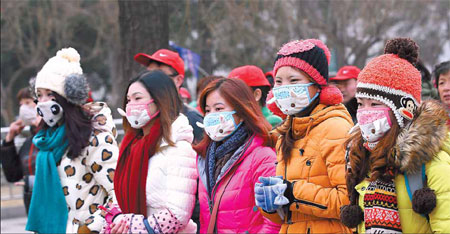 |
|
Tourists wear protective face masks in Beijing on Saturday morning, when the city was hit by heavy smog.[Wang Jing / China Daily] |
A red alert is the highest level in all regions that have formulated emergency plans, but different regions have differing requirements that must be met before a red alert can be issued.
In Beijing, a red alert is issued if estimates suggest that in the following three days the AQI will be higher than 300, while in Guangzhou, Guangdong province, red alerts are issued if the following two days are likely to see an AQI above 300. In Shanghai, however, the requirement is just one day, but the AQI has to reach at least 450.
So far, only a few cities have issued a red alert. On Dec 4, Nanjing in Jiangsu province issued its first red alert because the AQI was expected to be higher than 300 the next day. But in February, the city government revised its emergency plan and raised the bar for the issuance of a red alert to the same level as used in Shanghai, 450 or higher.
The move was controversial. Many locals were concerned that setting the bar so high could result in red alerts being shelved forever because the highest AQI level recorded in Nanjing is 376.
Local environmental officials said the move was aimed at keeping pace with the provincial government's standards and to avoid the anomalous situation whereby Nanjing issued a red alert, while the rest of the province was on yellow.
"It's hard to say right now whether Nanjing will have a day when the AQI rises to 450 or higher in the future. Meanwhile, the social costs should be taken into consideration when setting the levels. The use of a red alert results in huge social costs, so it can't be done too frequently," Modern Bulletin reported in February, quoting an official from the provincial environmental protection department.
In addition to the piecemeal requirements for issuing red alerts, environmental experts said that although different regions employ different emergency measures, they also have many problems in common.
Evaluation of measures
Yu Fang, a researcher at the Chinese Academy of Environmental Planning, who is analyzing pollution sources in a number of cities in Hebei, said it's essential to evaluate the actual effectiveness of an emergency plan.
"The evaluation should involve the measures taken by different government bodies in response to an alert, the extent to which air pollution is alleviated after all the measures have been taken, and the impact of the plan on local residents and the local economy, especially as alerts may be issued more frequently in the future," she said.
Sui Xiaochan, head of the environmental emergency and accident investigation center at the Environmental Protection Ministry who was in Tianjin when it issued its first alert, used the northern municipality as an example.
She said that when Tianjin issues a yellow alert, the local government requires about 100 key businesses to cut emissions by 20 percent, but for the measure to be effective, the companies must have the ability to comply and the government needs to find ways of verifying that the action has been taken. Moreover, what punishments can be imposed on those who fail to comply?
Another major problem concerns accurate communication between government departments. On Feb 13, when the emergency response office in Baoding, a city in Hebei, issued a yellow alert, officials from several other local governmental departments said they hadn't been informed about it, according to reports on China National Radio.
Back in December, Tianjin residents received two text messages during the same evening, one from the environmental department, the other from the transport department. The first message said the use of automobiles would be restricted the next day, but that statement was contradicted by the second message, from the traffic department, which said no restrictions would be imposed.
The confusion and apparent dislocation shows that, despite all the good intentions, the country's ability to respond to severe outbreaks of air pollution is still in the early stages and has a long way to go, said Zhang Yuanhang, a professor at the College of Environmental Science and Engineering at Peking University.
Contact the writer at wuwencong@chinadaily.com.cn
